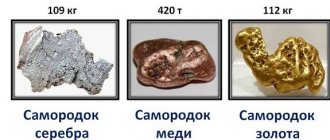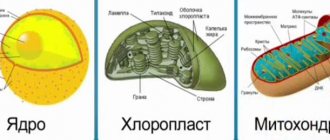general description
Sulfuric acid (H2SO4) has the characteristic properties of acids and is a strong oxidizing agent. It is the most active inorganic acid with a melting point of 10°C. The acid boils at 296°C, releasing water and sulfur oxide SO3. It is capable of absorbing water vapor, so it is used to dry gases.
Rice. 1. Sulfuric acid.
Sulfuric acid is produced industrially from sulfur dioxide (SO2), which is formed when sulfur or sulfur pyrites burn. There are two main ways to form acid:
- contact (concentration 94%) – oxidation of sulfur dioxide to sulfur trioxide (SO3) followed by hydrolysis:
2SO2 + O2 → 2SO3; SO3 + H2O → H2SO4; - nitrous (concentration 75%) – oxidation of sulfur dioxide by nitrogen dioxide during the interaction of water:
SO2 + NO2 + H2O → H2SO4 + NO.
A solution of SO3 in sulfuric acid is called oleum. It is also used to produce sulfuric acid.
Rice. 2. The process of producing sulfuric acid.
Reaction with water releases a large amount of heat. Therefore, acid is added to water, and not vice versa. Water is lighter than acid and remains on the surface. If you add water to acid, the water will instantly boil, causing the acid to splash.
Properties
Sulfuric acid forms two types of salts:
- acidic – hydrosulfates (NaHSO4, KHSO4);
- medium – sulfates (BaSO4, CaSO4).
The chemical properties of concentrated sulfuric acid are presented in the table.
| Reaction | What is formed | Example |
| With metals | - Salt; – water; – sulfur oxide; – sulfur; – hydrogen sulfide | – With active: 2H2SO4 + Mg → MgSO4 + SO2 + 2H2O – with metals of medium activity: 4H2SO4 + 2Cr → Cr2(SO4)3 + 4H2O + S; – with low activity: 2H2SO4 + Cu → CuSO4 + SO2 + 2H2O |
| With non-metals | – Acid; – water; – sulfur oxide | 2P + 5H2SO4 → 2H3PO4 + 5SO2 + 2H2O |
| With oxides | - Salt; – water; – sulfur oxide | – Metals: H2SO4 + CuO → CuSO4 + H2O; – non-metals: H2SO4 + CO → CO2 + SO2 + H2O |
| With reasons | - Salt; – water | H2SO4 + 2NaOH → Na2SO4 + 2H2O |
| With salts | - Salt; - carbon dioxide; – water; – acid | Na2CO3 + H2SO4 → Na2SO4 + CO2 + H2O Qualitative reaction: H2SO4 + BaCl2 → BaSO4 (white precipitate) + 2HCl |
| Oxidation of complex substances | – Free halogens; – sulfur oxide; – water | H2SO4 + 2HBr → Br2 + SO2 + 2H2O; H2SO4 + 2HI → I2 + 2H2O + SO2 |
| Charring of sugars (cellulose, starch, glucose) | – Sulfur oxide; - carbon dioxide; – water | C6H12O6 + 12H2SO4 → 18H2O + 12SO2↑ + 6CO2↑ |
Rice. 3. Reaction with sugar.
Dilute acid does not oxidize low-active metals that appear in the electrochemical series after hydrogen. When interacting with active metals (lithium, potassium, sodium, magnesium), hydrogen is released and a salt is formed. Concentrated acid exhibits oxidizing properties with heavy, alkali and alkaline earth metals when heated. There is no reaction with gold and platinum.
Sulfuric acid (diluted and concentrated) in the cold does not interact with iron, chromium, aluminum, titanium, and nickel. Thanks to the passivation of metals (the formation of a protective oxide film), sulfuric acid can be transported in metal tanks. Iron oxide breaks down when heated.
Oxygen-containing sulfur(VI) compounds
Chapter 4. Oxygen subgroup and its typical representativesChemical properties of concentrated sulfuric acid. There are two features of this acid:
- extreme hygroscopicity, i.e. the ability to add water;
- strong oxidizing properties due to the highly oxidized sulfur atom (+6) in the molecule.
When conducting experiments with concentrated acids (sulfuric, nitric, hydrochloric, phosphoric, etc.), you must strictly follow the safety rules:
- 1. Conduct experiments in a fume hood in a chemical laboratory. 2. Conduct experiments with a small amount of reagents in thin-walled, clean containers. 3. Have neutralizing agents ready. 4. Wear safety glasses to prevent acid splashes from getting into your eyes. Observe reactions at some distance from the eyes. 5. Do not leave chemical dishes dirty. 6. After finishing the experiments, put the work area in order, treat the surface of the table, where drops of acid could fall, with neutralizing solutions and water, and wipe dry.
| Remember! Sulfuric acid causes severe burns if it gets on the skin of the hands or face if handled carelessly. If sulfuric acid gets on your skin or clothing, it should be immediately washed off with plenty of running water, and the affected area should then be carefully moistened with a diluted ammonia solution or baking soda solution and rinsed off again with water. |
1. Concentrated sulfuric acid is a strong oxidizing agent. It oxidizes simple substances (non-metals, metals) and complex ones.
a) Oxidation of non-metals. Coal and sulfur are oxidized with sulfuric acid to their dioxides:
b) Oxidation of complex substances:
c) Interaction of concentrated sulfuric acid with metals. Unlike dilute sulfuric acid, concentrated acid oxidizes almost all metals in the activity series to hydrogen, with the exception of aluminum, iron, chromium and nickel, which under its influence become covered with a solid insoluble oxide film (this property is used for storing and transporting anhydrous sulfuric acid in steel cylinders). Interacting with active metals (Na, K, Ca), sulfur is reduced to atoms in the oxidation state -2.
With metals of intermediate activity, sulfur is reduced to atoms in the oxidation state +4 and 0.
Concentrated sulfuric acid also reacts with low-active metals that are in the activity series after hydrogen (copper, silver, mercury). It does not react with platinum and gold. Reactions occur when heated.
Let us verify the reality of the occurrence of one of these reactions and its conditions.
- Demonstration experience.
Reaction of concentrated sulfuric acid with copper.
1. Put several pieces of copper shavings or copper wire into a demonstration tube and add concentrated sulfuric acid. No changes are observed.
2. Place wet litmus paper on the edge of the test tube. Warm the test tube carefully. Sulfur dioxide is released (it is determined by the smell or redness of litmus paper moistened with water), the solution in the test tube becomes blue, copper sulfate is formed, and a redox reaction occurs, oxidizing copper with acid.
This process includes two reactions: a redox reaction and an exchange reaction of salt formation, which occurs without changing oxidation states.
2. Concentrated sulfuric acid actively interacts with water , forming hydrates:
- H2SO4 + nH2O = H2SO4 • nH2O + Q
This property is widely used in the laboratory and industry for drying gases and for dehydrating certain substances.
Sulfuric acid so greedily attaches water to itself that it is even capable of taking away from substances the elements that make up water (hydrogen and oxygen), for example, from organic substances consisting of the elements carbon, hydrogen and oxygen - sugar, fiber, starch, etc. Let's verify this through experiments.
- Demonstration experiments.
1. Charring of the torch and paper , a) Dip the torch into concentrated sulfuric acid. She turned black. Let's rinse it in water. Consider a splinter: coal
- she got charred. b) Place a sheet of white paper on the tile. Dip the splinter into a solution of sulfuric acid (1:5) and then write the formula of sulfuric acid on a piece of paper. Carefully heat the sheet over the flame of an alcohol lamp. The acid becomes more concentrated and chars the paper, on which the inscription clearly appears: H2SO4.
2. Charring of sugar . Place about 10 g of powdered sugar (powdered sugar) in a small beaker. Carefully pour about 5 ml of concentrated sulfuric acid onto a glass rod and stir quickly until a thick paste forms, leaving the rod in the middle of the glass. A reaction occurs, the sugar is charred (in this case, the coal is partially converted into carbon dioxide due to the reduction of sulfuric acid to sulfur dioxide). The released gases (CO2, SO2) swell the remaining mass of carbon, which comes out of the cup (Fig. 23). Using a glass rod, this porous carbon mass can be removed in the form of a “popsicle”:
С12Н22O11 + H2SO4 → 12С + H2SO4 • 11Н2O
Industrial significance and use of sulfuric acid. Sulfuric acid is the most important product of the chemical industry. In industrialized countries, the production of sulfuric acid ranks first among other chemical industries. The development of industry in general and the chemical industry in particular is judged by the production and use of sulfuric acid. Sulfuric acid is used in almost all areas of the national economy and is a strategic type of industrial product.
Sulfuric acid is consumed in huge quantities (more than 50% of all acid produced) for the production of mineral fertilizers (superphosphate, ammonium sulfate, etc.). It is used to obtain other acids (hydrochloric, acetic, hydrofluoric, phosphoric, etc.) from their salts. A lot of sulfuric acid is used to purify petroleum products from harmful impurities. Sulfuric acid is necessary in the production of explosives, plastics, artificial fibers, and dyes. It is used in mechanical engineering to clean the surface of metals before electrode coating with other metals (nickel plating, chrome plating, galvanizing). Sulfuric acid is used in batteries used in vehicles.
Salts of sulfuric acid are also widely used. Ammonium and potassium sulfates are used as fertilizers; sodium sulfate - in medicine (as a laxative), in the production of soda and glass. Calcium sulfate (in the form of crystal hydrates: gypsum, alabaster, etc.) is widely used in construction and in medicine; Vitriol (iron and copper) is used to control plant pests when spraying, zinc sulfate is used for the production of mineral paints and in medicine. It is difficult to list all the applications of sulfuric acid and its salts. They are also indispensable in chemical laboratories for scientific research and training.
Basic Concepts
Sulfur (VI) oxide • Properties of sulfuric acid • Qualitative reaction to sulfate ion • Sulfates • Sulfuric acid
Questions and tasks
1. Characterize the structure and properties of sulfur oxide (VI).
2. Describe sulfuric acid as an electrolyte, write down the dissociation equations for sulfuric acid and reveal their essence.
3. Describe the physical properties and oxidizing properties of concentrated sulfuric acid. Give them a scientific basis. Draw up equations for the reactions of concentrated sulfuric acid with magnesium and mercury and diagrams of their electronic balance. Why do these reactions produce different products?
4. When a solution of sulfuric acid weighing 32 g interacted with an excess solution of barium nitrate, a precipitate weighing 11.4 g, insoluble in water and acids, was released. Determine the mass fraction of sulfuric acid in the original solution.
5. What is the volume (l) that occupies 8.0 g of sulfur(IV) oxide at n. y.: 1) 2.8; 2) 5.6; 3) 11.2; 4) 22.4?
6. In a gas mixture consisting of sulfur (IV) oxide and oxygen with a relative density of the mixture for hydrogen (dH2) equal to 24, part of the sulfur (IV) oxide reacted and a gas mixture was formed with dH2 25% greater than the density of the initial mixture . Calculate the composition of the equilibrium mixture in percent by volume.
7. What can be said about the hygroscopicity of concentrated sulfuric acid and what precautions should be taken when diluting it with water? Offer drawings, riddles, stories that reflect this phenomenon.
8. Compose a crossword puzzle on the topic “Oxygen compounds of sulfur.”




